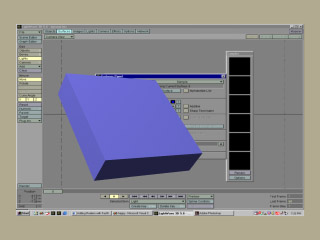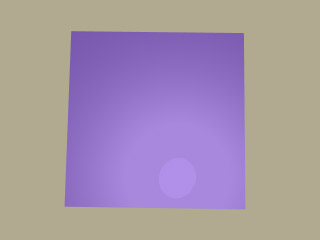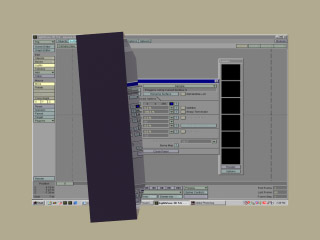|
What's that LW_FastFresnel shader that comes with LightWave?
Right. Commit the following truism to memory: FastFresnel is your friend.
Now let's see how to use it to make super-realistic chrome, lacquer, and paint surfaces.
The idea is that we're going to look at a real surface, make real observations,
and simulate them using FastFresnel.
Ooh. Cool. Is that a lot of work?
This is a highly easy procedure, consisting of only three steps.
But first, you'll need a real sample of the surface you're trying to create.
For example, to make a nice paint surface, get a paint can lid with some paint on it.
If it's not possible to get a real sample, some really good reference photos will do.
Step 1
The first thing we're going to do is recreate your working environment in Layout.
Luckily, a highly simplified version will do just fine.
All we need is a Box representing your computer monitor, another box representing
your material sample, and a Light representing the major lightsource in your actual
working environment, along with a sphere or other appropriate shape representing your
lightbulb. I suggest mapping a screenshot of your actual monitor onto
the virtual monitor (with LightWave showing, of course) and setting Luminosity to 100%.
You only have to set up this scene once, of course.
You can re-use it anytime you want to use this method of surface measurement.
|
 |
Here's my set-up. You can see my monitor (big box), my sample (little box), my lightbulb
(sphere), and my eyes (camera).
|
 |
Here's my view of my monitor. I'm holding up the (unsurfaced) sample in front of it.
This isn't a real photograph :)
|
|
Step 2
The goal of this step is to capture the appearance of the surface when viewed head-on.
This involves setting up two camera-object views. I put them on frames 1 and 2 in my scene.
|
 |
Frame 1
I'm looking straight at my monitor, and I'm holding up the sample face-on.
From this view, comparing reality and renders, I set the Surface Color and Diffuse.
I would also set the Transparency in this view, but my sample is opaque.
The sample appears a dark purple from this view.
|
 |
Frame 2
I've got my back to the light, and I'm holding up the sample face-on.
Notice the reflection of the light in the sample. You'll need Trace Reflections for this view.
From this view, comparing reality and renders, I set the Reflectivity and Specularity, in that order.
The lightbulb serves as a useful indicator of Reflectivity.
|
|
Step 3
We have the head-on appearance of the surface.
Our next goal is to capture the appearance of the surface when viewed edge-on.
This involves setting up two more camera-object views. I put them on frames 3 and 4 in my scene.
First, add the LW_FastFresnel Shader Plugin to our surface.
Open up the FastFresnel options and turn everything off for starters.
|
 |
Frame 3
I'm looking straight at my monitor, and I'm holding up the sample almost edge-on.
From this view, comparing reality and renders, I set the Reflectivity and Diffuse
in the FastFresnel panel, in that order.
Again, I would also set the Transparency in this view, but my sample is opaque.
The reflection of the image on my monitor is an excellent indicator of Reflectivity.
My sample is quite reflective at this angle.
|
 |
Frame 4
I'm facing the light, and I'm holding up the sample almost edge-on,
in such a way that I get a reflection of the lightbulb on the sample.
From this view, comparing reality and renders, I set the Specularity in the FastFresnel panel.
I can also double-check my Reflectivity and Diffuse settings.
You may need to squint a little for this step, to avoid burning a temporary spot in your retina.
|
|
Now, save your surface!
Then you can load up that animation you've been working on with that fancy painted object,
and apply your saved surface to it. You may also want to apply the tips for nice reflections
found in my Shiny Chrome Things tip.
|
 |
 |
|
Here's a couple test renders of the result.
Note how the reflectivity at sharp angles adds an effective dose of reality to this machine part.
Of course, this particular kind of purple lacquer would probably show up on a car more often than
on a machine part :)
Now you know what people are talking about when they say "Fresnel". - GLYPH
|







